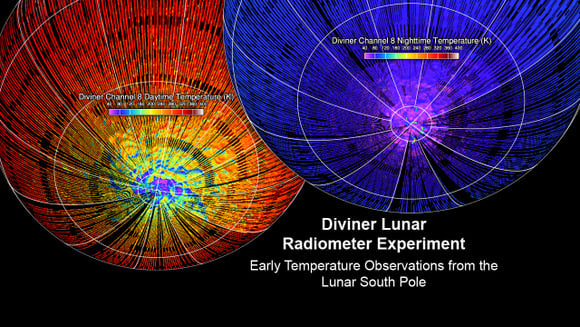[/caption] The Lunar Reconnaissance Orbiter has successfully completed its testing and calibration phase and is now in its science and mapping orbit of the moon. Already, the spacecraft has made significant progress in creating the most detailed atlas of the moon's south pole, and Thursday mission scientists reported some of the early science results, including "tantalizing" hints of water at the Moon's south pole. So far, the data returned from LRO's seven instruments "exceed our wildest expectations," said Richard Vondrak, LRO project scientist at NASA Goddard Space Flight Center . "We're looking at the moon now with new eyes."
Last Tuesday, a final maneuver put LRO 50 km (31 miles) above the Moon, closer than any previous orbiter. LRO has already proved its keen eyes, i
maging fine details of the Apollo landing sites
earlier this summer with the LROC, the Lunar Reconnaissance Orbiter Camera.
Coldest place in the solar system
According to the first measurements from the Diviner instrument, which has infrared radiation detectors, LRO found that temperatures at about 35 Kelvin, or -238º Celsius deep in some permanently shaded regions. Vondrak said that these bitterly cold regions at the south pole "are perhaps the coldest part of the solar system." With such cold temperatures, volatiles like water ice could be present, preserved for billions of years. [caption id="attachment_40609" align="aligncenter" width="580" caption="This image shows neutron flux detections around the lunar south pole from LEND. Credit: NASA/Institute for Space Research (Moscow)"]
[/caption] And indeed, first results from LRO's Lunar Exploration Neutron Detector, or LEND instrument found hallmarks of hydrogen—a potential marker of water— not only in deep, dark craters, but in unexpected places as well.
"What it also seems to indicate is that the hydrogen is not confined to permanently shadowed craters," said Vondrak. "Some of the permanently shadowed craters do indeed contain hydrogen. Others, on the other hand, do not appear to have hydrogen. And in addition, there appears to be concentrations of hydrogen that are not confined to the permanently shadowed regions."
Surface topography
[caption id="attachment_40610" align="aligncenter" width="580" caption="This mosaic shows altitude measurements from the LOLA instrument. Credit: NASA's Goddard Space Flight Center"]
[/caption] Data from LRO's Lunar Orbiter Laser Altimeter, or LOLA, give scientists a detailed look at the topography of the lunar south pole, shown here. Red regions are high altitude, and blue regions are low altitude.
Some of the first results have turned up fresh craters, unknown boulders, and smooth sites that would be good landing sites for future humans or robotic missions. However, most regions are filled with rough terrain, which will make in situ exploration difficult. The roughness is probably a result of the lack of atmosphere and absence of erosion from wind or water, according to David Smith, LOLA principal investigator.
Another instrument, LRO's Cosmic Ray Telescope for the Effects of Radiation instrument is exploring the lunar radiation environment and its potential effects on humans during record high, "worst-case" cosmic ray intensities accompanying the extreme solar minimum conditions of this solar cycle, showing damaging amounts of radiation at various points. [caption id="attachment_40611" align="aligncenter" width="580" caption="This Mini-RF image shows radar imagery of the lunar south pole. Credit: NASA/APL/LPI"]
[/caption] The Mini RF Technology Demonstration on LRO has confirmed communications capability and produced detailed radar images of potential targets for LRO's companion mission, LCROSS, the Lunar Crater Observation and Sensing Satellite, which will impact the moon's south pole on Oct. 9.
LRO's prime science mission will last a year.
"The LRO instruments, spacecraft, and ground systems continue to operate essentially flawlessly," said Craig Tooley, LRO project manager at Goddard "The team completed the planned commissioning and calibration activities on time and also got a significant head start collecting data even before we moved to the mission's mapping orbit."
"There's still an awful lot to be done," says Michael Wargo, chief lunar scientist at NASA Headquarters in Washington, D.C. "And the maps will only get better."
See more information, including more images and flyover videos
here.
 Universe Today
Universe Today
